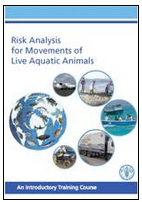An introductory training course on risk analysis on movements of live aquatic animals

Risk analysis is complex subject that is best learned by actual experience. This manual will assist national competent authorities and others involved in the assessment and management of risks associated with the international or domestic moment of live aquatic animals in training professional staff and raising awareness and understanding among other stakeholders of the principles and methodology of risk analysis. Using the training course manual and the recommended supplementary materials, responsible managers will be able to train staff in the planning and supervision of risk analyses. The training course will also assist specialists in the fields of disease, genetics or ecology of aquatic animals to successfully conduct risk analyses in a manner that incorporates best scientific knowledge, is transparent and includes adequate stakeholder consultation.
Using a structured step-wise process, the training course guides trainees through the risk analysis process as applied in the analysis of ecological, genetic and pathogen risks. Through the use of a series of lectures (provided on an accompanying CD in the form of 11 PowerPoint presentations), and using case studies and a series of five linked working group exercises that should be adapted by trainers to reflect local situations and priorities, the course provides an in-depth look at risk analysis as currently applied for evaluation of risks due to pathogens (import risk analysis). Trainees are guided from the initial process of establishing a commodity description and scoping a risk analysis through to conducting the four risk analysis components of hazard identification, risk assessment, risk management and risk communication. They are also encouraged to evaluate their national experiences with introductions and transfers of live aquatic animals, and to assess their current capacity, and any policy, legislative or technical improvements needed to effectively implement risk analysis for the safe movements of live aquatic animals.a